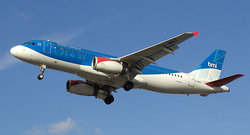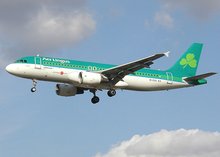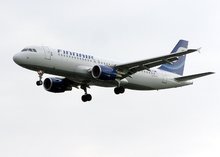Airbus A320
|
|
Missing image Airbus.a320family.750pix.jpg The Airbus A320 family from the smallest (A318) to the largest (A321) |
Missing image A320.flightdeck.750pix.jpg The flight deck of the Airbus A320, using digital fly-by-wire for primary flight controls, side-stick controllers in place of the usual control columns, and six large electronic displays. |
The Airbus A320 is a short to medium range commercial passenger aircraft manufactured by Airbus. It was the first airliner with a digital fly-by-wire flight control system, where the pilot controls flight surfaces through the use of electronic signals rather than mechanically with pulleys and hydraulic systems.
| Contents |
History
The first Airbus 320 family variant, the A320-100, was launched in 1984 and entered service in 1988, with the winglet equipped A320-200 taking over production at aircraft 22. Some A320-100s were retrofitted to -200 specification excluding winglets. The A321 entered service in 1994, the A319 in 1996 and the A318 in 2003.
The initial Air France A320 crashed during an airshow in Habsheim, France killing three passengers. While the crash was caused by pilot error in using the novel fly-by-wire system, the investigation left numerous unanswered questions. Switzerland's Institute of Police Forensic Evidence and Criminology later determined that the plane's flight data recorder had been substituted after the crash, throwing the entire investigation into doubt.
As the aeroplane matured, the incidence of such accidents diminished and seems to have had no impact on the aircraft's huge popularity.
Technology
The new-technology items introduced include:
- the first fully digital fly-by-wire flight control system in a civil airliner, hence the first with relaxed stability
- the first civil airliner to use sidesticks instead of control columns
- 2-man crew (compared to 3-man crew of the 727)
- fully featured glass cockpit rather than the hybrid versions found in A310, Boeing 757 and Boeing 767
- the first narrowbody airliner with a significant amount of the structure made from fiber composites
- centralized maintenance diagnostics systems allowing the technicians to do diagnostics of aircraft system items from the cockpit
- the first narrowbody airliner with a containerized cargo system
All these features help make the A320 family more economical airliners to operate relative to older designs.
Variants
The A320 has given rise to a family of aircraft which share a common design but are a little smaller (the A319), a lot smaller (the A318), or a little larger (the A321). Passenger capacity is between 100 to 220. They compete with the Boeing 737, 757-200, and 717. All have the same pilot type-rating.
Technically, the name "A320" only refers to the original mid-sized aircraft, but it is often informally used to indicate any of the A318/A319/A320/A321 family. All variants are ETOPS rated.
A320
The A320 series has two variants, the A320-100 and A320-200. The A320-200 is the definitive version as very few A320-100s were produced. The A320-200 features wingtip fences and increased fuel capacity over the A320-100 for increased range: other than that differences are minimal.
Typical range with 150 passengers for the A320-200 is about 2900 nautical miles (5,400 km). It is powered by two CFMI CFM56-5 or IAE V2500 with thrust ratings between 25,500 to 27,000 pounds force (113 kN to 120 kN).
A319
Aeroflot_A319_VP-BWA_in_SXF.jpg
This is a shortened, minimum change version of the A320. With virtually same fuel capacity as the as A320-200, and fewer passengers, the range with 124 passengers in 2-class configuration extends to 3,900 nautical miles (7200 km), the highest in its class. The A320 and A319 are the most popular variants of the A320 family. In 2003 easyJet took delivery of A319s with smaller galleys (as easyJet does not serve meals) and 156 seats in a single class configuration. To satisfy evacuation regulations additional over-wing exits were facilitated by using the A320 centre section.
The massive easyJet order of 120 A319s plus 120 options was among the biggest aircraft sales deals in recent times. It set the precedent for other low-cost airlines to consider the A320 family rather than the traditional choice, the Boeing 737, new or secondhand.
It is powered by the same types of engine as the A320. JAA certification and service entry, with Swissair, took place in April 1996.
A319CJ
This is the corporate jet version of the A319. It incorporates extra fuel tanks which are installed in the cargo compartment giving a range of 6,500 nautical miles (12,000 km). Upon resale the aircraft can be reconfigured as a standard A319 by removing its extra tanks, thus maximising its resale value. It is also known as the ACJ, or Airbus Corporate Jet.
Seating is up to 39 passengers but may be outfitted by the customers into any configuration. DaimlerChrysler and PrivatAir are among its users. The A319CJ competes with other corporate jets such as the Gulfstream V, the Boeing 737-based BBJ, and Bombardier's Global Express. It is powered by the same engine types as the A320.
A319LR
This version features an all-business class layout with 48 seats, specifically tailored for exclusive business class services on intercontinental routes. The A319LR, compared to the A319CJ, has four auxiliary fuel tanks instead of six. Typical range is 4,500 nautical miles (8300km), making it the longest range airliner in the A320 family.
Lufthansa operates a premium business service between Germany and the USA using a fleet of A319LRs operated by the swiss PrivatAir.
A321
This is a lengthened, minimum change version of the A320. The wing area is slightly enlarged and the undercarriage is strengthened, with higher thrust variants of both CFM56 and V2500. Some carriers have bought the A321 over the Boeing 757 as it shares type commonality with the A318, A319, and A320. Type certification was awarded in December 1993 by the JAA.
Typical range with 186 passengers for the A321-100 is about 2,300 nautical miles (4,300 km). It is powered by two CFM56-5 or IAE V2500 engines with a thrust rating of 31,000 pounds force (138 kN).
The A321-200 has extra fuel capacity bringing the range with 186 passengers up to about 3,000 nautical miles (5,500 km). The A321-200 is powered by two CFM56-5 or IAE V2500 engines with a thrust rating of about 33,000 pounds force (147 kN).
A318
Frontier_Airlines_plane_at_Denver_International_Airport.jpg
The A318, also known as the "Mini-Airbus", is the smallest member of the A320 family. During development, it was known as the "A319M3," thus indicating its history as a direct derivative of the A319. "M3" indicates "minus three fuselage frames." The aircraft is six metres shorter and 14 tonnes lighter than its predecessor. Pilots who are trained on the other A320 variants may fly the A318 with no further certification, since it features the same type rating as its sister aircraft.
The A318 has a passenger capacity of 109 in a two-class configuration. It is intended to replace early Boeing 737 and Douglas DC-9 models, though it is also a rival to the current 737-600 and 717 (essentially an updated DC-9).
The A318 is available with a variety of different maximum take-off weights (MTOW) ranging from a 59 tonne, 2,750 km (1,500 nautical mile) base model to a 68 tonne, 6,000 km (3,250 nautical mile) version. The lower MTOW enables it to operate regional routes economically whilst sacrificing range and the higher MTOW allows it to complement other members of the A320 family on marginal routes. The lighter weight of the A318 gives it an operating range 10% greater than the A320, allowing it to serve some routes that the A320 would be unable to: London-Jerusalem and Singapore-Tokyo, for instance. Its main use for airlines, however, is on short, low-density hops between medium cities.
The A318 has one major disadvantage when compared to other A320 variants: its cargo doors are too small to accommodate standard air freight containers, making it nearly useless for carrying large cargo.
During the design process, the A318 ran into several stumbling blocks. The first one was the decline in demand for new aeroplanes following the attacks of September 11, 2001. Another one was the new Pratt & Whitney turbofan engines, which burned more fuel than expected: by the time CFMI had a more efficient engine ready for market, many A318 customers had already backed out, including Air China, American Airlines, and British Airways. While Airbus was hoping to market the A318 as a regional jet alternative, laws in both the U.S. and Europe have kept it in the same class as larger aircraft for calculating landing fees and the like, so regional operators have avoided it.
It is powered by two CFM56-5 or Pratt & Whitney PW6000 with thrust ranges between 21,600 to 23,800 lbf (96 to 106 kN) thrust. Launch customers Frontier Airlines, America West and Air France took deliveries in 2003, with Frontier receiving their models in July of that year. The price of an A318 ranges from $39 to $45 million, and operating costs are around $3,000 for a 500-mile flight.
A320 market share
Boeing has shipped 1,500 737s in just 6 years, with a total of 5,415 ordered since the 1960's, compared to 3,117 Airbus A320s ordered since introduction around 15 years ago, making the A320 faster selling on the average (195 aircraft per annum versus 144 aircraft per annum for the 737). The recent trend of fleet renewals by low-cost airlines like easyJet, jetBlue, Air Berlin and Virgin America has favoured the A320 family, thus stagnating the 737's further fleet growth.
However, these sales figures include the Airbus A321, which is intended to compete with another Boeing product, the 757, and the Airbus A318, which is intended to compete with the 717.
According to the Boeing website, the Next-Generation Boeing 737 (-600 to -900) noting that -900 is a perfect replacement for the 757-200, was the fastest plane to reach 1,500 orders, taking 6 years, compared to 13 years for the Airbus A320, and 16 years for the Boeing 727.
Determining the sales winner is largely a matter of which statistics one favors. The 737 is the overall sales winner at 5,499 compared to the A32x at 3,272. Average per-year sales over the lifetime of the entire airframe would place the A32x at 163.6, and the 737 at 141. The total of the current models would place the A32x at 3,272 and the 737NG at 2,367. And the sales of the current models over each year they were on sale would put the 737NG at 215.2 and the A32x at 163.6.
Accident summary
(As of 2004 for whole A320 Family)
- Hull-loss Accidents: 11 with a total of 327 fatalities
- Other occurrences: 2 with a total of 0 fatalities
- Hijackings: 6 with a total of 1 fatality
Specifications (A320)
General characteristics
- Crew:
- Capacity:
- Passenger:
- Freight: 16,300 kg
- Length 37.57 m
- Wingspan: 34.09 m
- Height: 11.76 m
- Wing area: 122.6 m²
- Empty: 41,000 kg
- Loaded: kg ( lb)
- Maximum takeoff: 73,500 kg
- Powerplant: 2 x CFM56-5 or IAE V2500 111 to 120 kN
Performance
- Cruise speed:
- Maximum speed:
- Range:
- Service ceiling:
- Rate of climb: m/min ( ft/min)
- Wing loading: kg/m² ( lb/ft²)
- Thrust/weight: N/kg (lbf/lb)
Related content
Template:CommonsTemplate:CommonsTemplate:CommonsTemplate:Commons
Related development
Similar aircraft
Designation series
A300 - A310 - A318 - A319 - A320 - A321 - A330 - A340 - A350 - A380
Related lists
List of airliners - List of civil aircraft - List of Airbus A320 operators
External links
- Details on the Airbus family of aircraft (http://www.airbus.com/dynamic/product/index_h.asp)
- History and pictures of the Airbus A319 (http://www.airliners.net/info/stats.main?id=23), A320 (http://www.airliners.net/info/stats.main?id=23), and A321 (http://www.airliners.net/info/stats.main?id=23)
- Airbus A318 (http://www.airbus.com/product/a318_introduction.asp)
- Aircraft-Info.net - Airbus A320 (http://www.aircraft-info.net/aircraft/jet_aircraft/airbus/A320/)
- Airbus A318 (http://www.planemad.net/data/list/Airbus/A318/), A319 (http://www.planemad.net/data/list/Airbus/A319/), A320 (http://www.planemad.net/data/list/Airbus/A320/), A321 (http://www.planemad.net/data/list/Airbus/A321/) Production List
- Aircraft-Info.net A320 (http://www.aircraft-info.net/aircraft/jet_aircraft/airbus/A320/)
- Airliners.net A320 Article (http://www.airliners.net/info/stats.main?id=23)
- Image of Cockpit (http://www.meriweather.com/320/320_main.html)
- The A320 Project Website (http://www.avsim.com/hangar/flight/a320project/main.html) (Construction of A320 Simulator)
- A320 accident database (http://www.airdisaster.com/cgi_bin/aircraft_detail.cgi?aircraft=Airbus+A320)
See also
|
Lists of Aircraft | Aircraft manufacturers | Aircraft engines | Aircraft engine manufacturers Airports | Airlines | Air forces | Aircraft weapons | Missiles | Timeline of aviation |
es:Airbus A320 fr:Airbus A320 ja:エアバスA320 nl:Airbus A320 pt:Airbus A320 fi:Airbus A320



